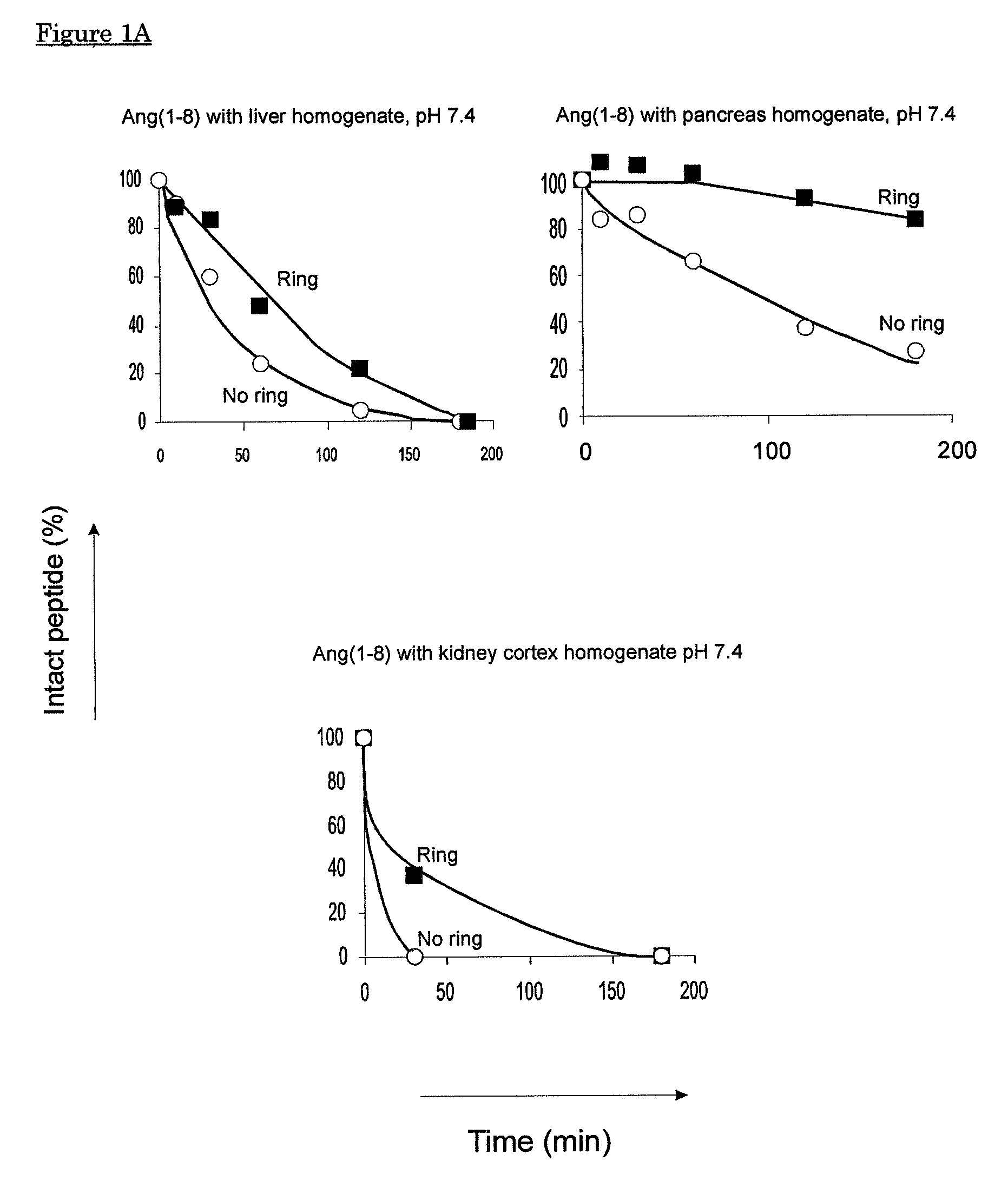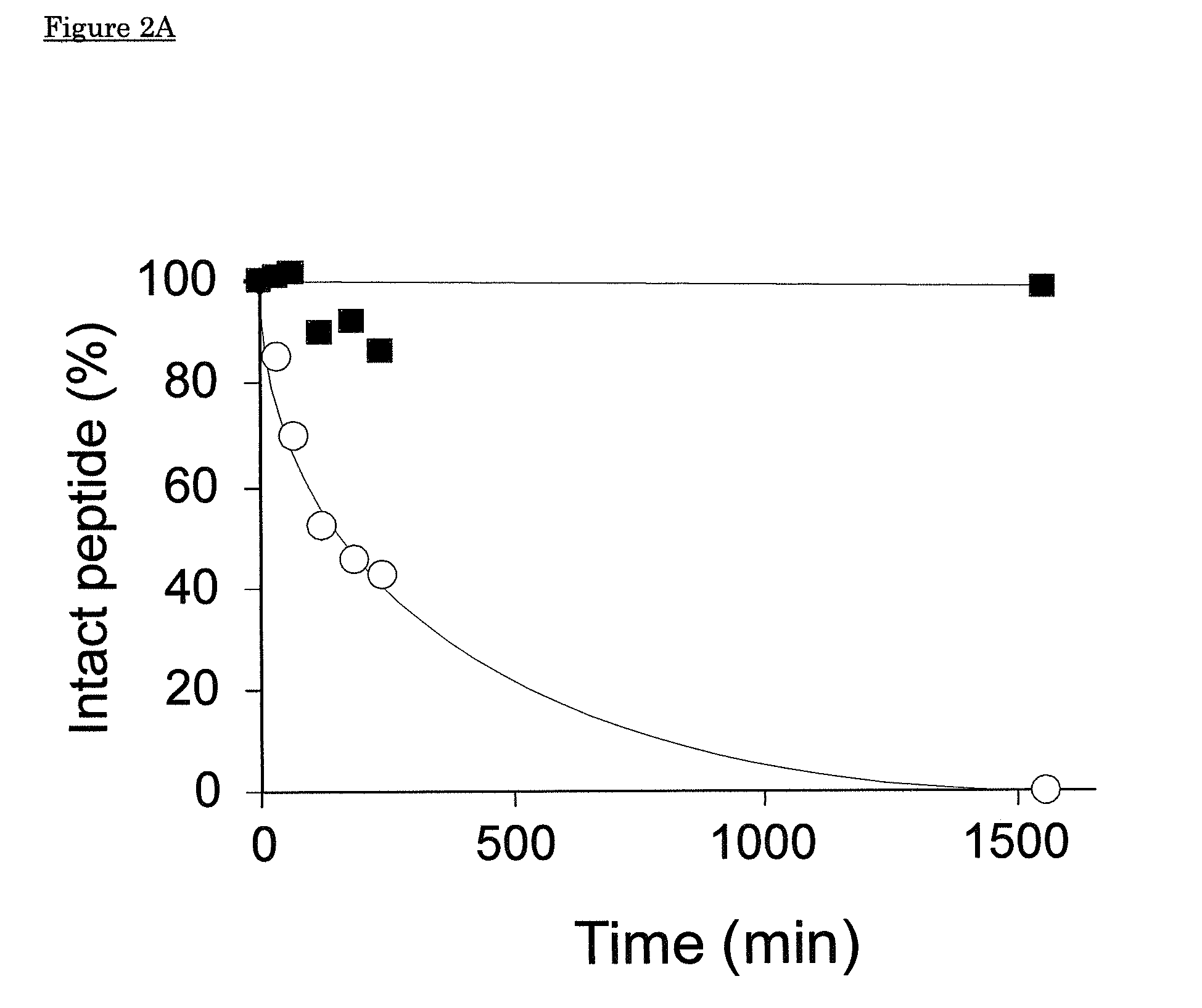Cyclic angiotensin analogs
an angiotensin and analog technology, applied in the field of analogs of angiotensins, can solve the problems of limited stability and severe restrictions in the medical and industrial application of small linear peptides
- Summary
- Abstract
- Description
- Claims
- Application Information
AI Technical Summary
Benefits of technology
Problems solved by technology
Method used
Image
Examples
example 1
Introduction of a Thioether Ring Between Position 4 to Position 7 Enhances the Proteolytic Resistance of Angiotensin(1-8) and Angiotensin(1-7)
[0135]Naturally occurring angiotensin(1-8) and angiotensin(1-7) are linear peptides with a short half-life as a result of rapid proteolytic breakdown. This example describes the introduction of a thioether-ring in Ang(1-7) and in Ang(1-8) between amino acids corresponding to positions 4 and 7 in Ang(1-8), i.e. Tyr4 and Pro7, resulting in [Cyc4-7]Ang(1-7) having the sequence Asp-Arg-Val-Ala-Ile-His-Ala (compound I in FIG. 7) and [Cyc4-7]Ang(1-8) having the sequence Asp-Arg-Val-Abu-Ile-His-Ala-Phe (compound A in FIG. 7), respectively.
[0136]Using homogenates of pig organs comprising several types of proteolytic enzymes, an enhanced resistance against enzymatic breakdown of [Cyc4-7]Ang(1-8) and [Cyc4-7]Ang(1-7) is demonstrated as compared to their non-cyclised, linear counterparts.
Experimental Procedure
[0137]Cyclized Ang(1-7) was produced both bio...
example 2
Thioether-ring-containing angiotensin is fully resistant against ACE
[0154]In vivo, ACE contributes strongly to breakdown of natural angiotensin(1-7) by cleavage of the peptide between the amino acids at positions 5 and 6. In view of the thioether bridge between positions 4 and 7 in the cyclised analogs of the invention, we hypothesised that the thioether bridge confers resistance against proteolytic degradation. In this example we investigated in vitro the resistance of angiotensin with and without thioether ring against angiotensin converting enzyme (ACE).
Methods.
[0155]Angiotensin Converting Enzyme (ACE) from Porcine kidney, SIGMA, was used at 4 nM final concentration, FIGS. 2A and 2B, or at 8 nM final concentration, FIGS. 2C and 2D. Natural Ang(1-7) was purchased from Bachem. All experiments were performed in duplicate in a waterbath at 37° C., incubations were performed in a buffer containing 100 mM Tris-HCl, 300 mm NaCl, 10 μM Zn, pH 8.3. Thioether-ring-containing angiotensin wa...
example 3
Thioether-ring-containing Ang(1-7) is highly stable in vivo
[0157]In this example we studied peptide stability during continuous ravenous infusion in the rat. It is demonstrated that a thioether ring in Ang(1-7) bridging positions 4 and 7 also confers proteolytic resistance in vivo, while the corresponding linear angiotensin without thioether ring is rapidly degraded.
Experimental
[0158]A male Sprague Dawley rat was kept under O2 / Isoflurane (1.5-2%) narcosis throughout the study. A jugular vein catheter was applied and connected to a syringe containing 0.9% physiological salt solution. The syringe was mounted onto an infusion pump and the flow rate set to 1 mL / hour. In the meantime a carotic artery catheter was applied and connected to a syringe containing 0.9% physiological salt solution. The rat was than heparinized via an injection in the penis vein. After 30 minutes the infusion pump syringe was replaced with a syringe containing a mix of 100 μM native Ang(1-7) and 100 μM methyllan...
PUM
| Property | Measurement | Unit |
|---|---|---|
| concentration | aaaaa | aaaaa |
| mass | aaaaa | aaaaa |
| mass | aaaaa | aaaaa |
Abstract
Description
Claims
Application Information
 Login to View More
Login to View More - R&D
- Intellectual Property
- Life Sciences
- Materials
- Tech Scout
- Unparalleled Data Quality
- Higher Quality Content
- 60% Fewer Hallucinations
Browse by: Latest US Patents, China's latest patents, Technical Efficacy Thesaurus, Application Domain, Technology Topic, Popular Technical Reports.
© 2025 PatSnap. All rights reserved.Legal|Privacy policy|Modern Slavery Act Transparency Statement|Sitemap|About US| Contact US: help@patsnap.com



